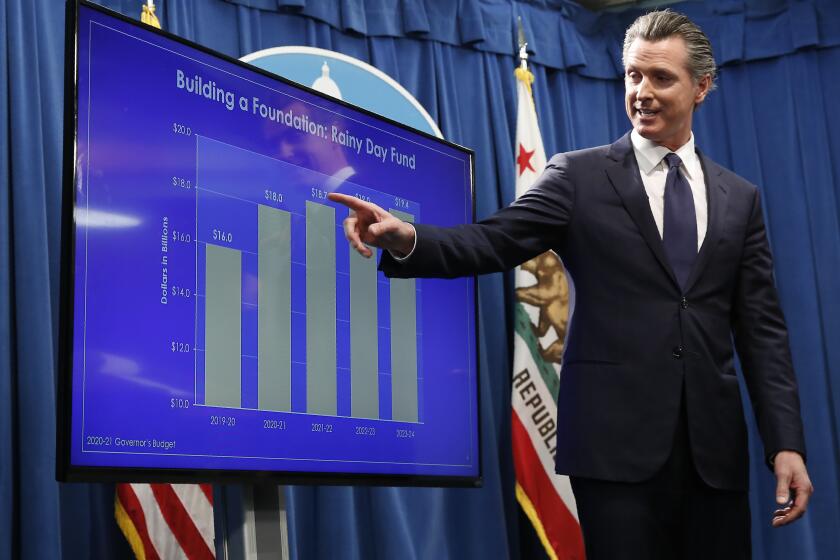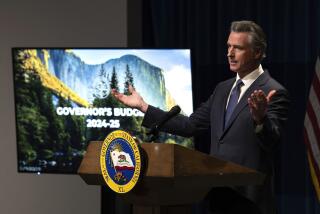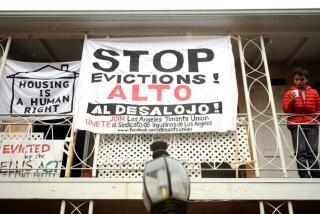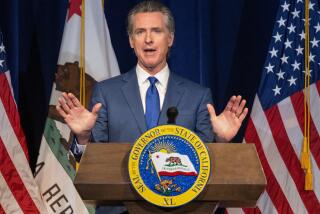Newsom proposes additional $600 stimulus checks and $5 billion toward rental assistance

Gov. Gavin Newsom proposed a second round of $600 state stimulus checks on Monday to hasten California’s recovery from the COVID-19 pandemic, hoping to expand the payments from low-income residents to also include middle-class families, and noting that doing so would ensure benefits for 2 out of 3 state residents.
The proposal to deliver $8 billion in new cash payments to millions of Californians is part of a $100-billion economic stimulus plan made possible in part by a budget that has swelled with a significant windfall of tax revenues, a surplus the governor put at $75.7 billion.
Newsom also proposed $5 billion to double rental assistance to get 100% of back rent paid for those who have fallen behind, along with as much as $2 billion in direct payments to pay down utility bills, proposals that were supported by legislative leaders on Monday.
“Direct stimulus checks going into people’s pockets and direct relief — that’s meaningful,” Newsom said during a visit to the Unity Council, a nonprofit social equity development corporation in the Fruitvale neighborhood of Oakland.
Under the governor’s proposal, which still requires approval from the Legislature during state budget negotiations, households earning up to $75,000 in adjusted gross income will be able to receive $600 direct payments if they did not receive a payment in the first round this year. State officials said the expanded program, when combined with the first round of state stimulus checks, would provide financial assistance to two-thirds of Californians.
Newsom said the state stimulus proposal represents the largest state tax rebate in U.S. history.
In addition to the $600 stimulus checks for eligible Californians, the governor is proposing that families with children get an additional $500, along with $500 in direct payments to immigrant families without legal status.
“We recognize the acuity of stress associated with back rent and we recognize the acuity of stress as it relates to gas, electric and water bills,” Newsom said. “We can keep people housed. We can keep people warm and safe, and make sure that they are getting the kind of resources that they deserve during this very challenging period of time.”
In January, the Legislature extended a moratorium on evictions through June 30 for those who pay at least 25% of their rent each month, offering to pay landlords 80% of the total amount of rent in arrears between April 2020 and March 2021 as long as landlords agree to forgive the remaining 20% and not pursue evictions.
The governor’s new proposal would provide funds to cover the remaining unpaid rent for low-income tenants.
The proposal was a relief to Tom Bannon, chief executive of California Apartment Assn., which represents landlords.
“Many of our members have provided housing for more than a year without compensation,” Bannon said. “We thank the governor for understanding the difficulties that both tenants and rental property owners have endured during the pandemic.”
Gov. Gavin Newsom will roll out this week what his advisors say is a $100-billion “California Comeback Plan,” beginning with $8 billion in cash payments to millions of the state’s residents.
The stimulus payments are part of what Newsom is calling a California Comeback Plan, pitched as he fights back against a Republican-led campaign to recall him from office. State election officials recently announced that proponents of the recall have turned in a sufficient number of signatures to trigger a special election in which voters could remove Newsom from office this fall.
Millions of Californians lost jobs or income since the pandemic began more than a year ago and the state ordered businesses to restrict operations and people to stay home. As vaccines and social distancing have significantly reduced the spread of the coronavirus, the state is poised to reopen much of its economy by June 15.
Still, many Californians are still struggling to pay rent and cover other expenses.
Oakland Mayor Libby Schaaf welcomed the new round of financial help, which she said is “an unprecedented moment where government is coming to the aid of those who need it the most.”
“Oakland is a city that has been hit hard by this pandemic,” she said. “Direct aid to people is what is going to get our economy roaring back.”
Newsom’s proposal is also supported by Chris Iglesias, CEO of the Unity Council.
“We are not going to leave anybody behind during this pandemic,” Iglesias said at the news conference. “We need that recovery.”
However, Newsom drew criticism Monday from Republicans, including former San Diego Mayor Kevin Faulconer, one of the candidates running in the recall election.
“Californians need permanent, real tax relief, not just one-time stimulus checks,” Faulconer said.
Assemblyman James Gallagher (R-Yuba City), whose lawsuit challenging Newsom’s use of executive powers during the pandemic was rejected by an appeals court this month, said he is generally supportive of what he called the “recall refund.”
“The California government has surplus revenue and putting this money back into the hands of taxpayers is the right thing to do,” Gallagher said. “It’s really the least Newsom could do considering the devastation caused to jobs and small businesses, the failure to provide timely unemployment assistance.”
This would be the second round of state stimulus checks proposed by the governor. In February, the governor signed legislation to provide low-income Californians with $2.3 billion in state stimulus checks. The money was provided for residents, including those earning $30,000 a year or less who receive the state earned income tax credit. It also went to people who file tax returns with an individual taxpayer identification number but who don’t have a Social Security number, the bulk of whom are immigrants in the country illegally.
Crafted by Gov. Gavin Newsom and legislative leaders last week, the pandemic assistance plan also includes $4 billion in grants, tax breaks and fee waivers for small businesses.
“They were left out of the federal supports. They will not be left out of the support coming from the state,” Newsom said of including people in the country illegally in the state stimulus program.
Families that file with an identification number and receive CalEITC have been eligible for up to $1,200 in the first round. The state said this month that so far 2.5 million Golden State Stimulus payments worth $1.6 billion have been issued.
“We passed the recovery package to get money into the pockets of Californians who were hit hardest by this pandemic, and that’s exactly what the Golden State Stimulus is doing,” Newsom said on May 6, noting that some Californians have not yet filed their 2020 taxes and may still qualify.
State officials said the cash payments were triggered in part by a 1979 voter-approved state constitutional amendment that requires tax rebates when revenues exceed a cap on government spending. That appropriations limit, loosened by subsequent ballot measures, has been significantly higher than state spending levels for the better part of the last four decades — allowing lawmakers to exclude billions of dollars in spending from the final calculation.
This year, awash in cash from a tax windfall and facing a historic slowdown in population growth used to determine the maximum spending allowed, the Newsom administration projects $16 billion in excess revenue. By law, half of that must go to public schools and the other half to taxpayer rebates — in this case, targeted toward middle-class adults and families.
The projected windfall is largely the result of strong capital gains on investments earned by California’s wealthiest taxpayers. The taxes paid by the top 1% of the state’s earners have accounted for as much as half of all income tax revenue in some years.
“That budget surplus is going back to the most vulnerable Californians, the ones who need help the most,” said Assemblyman Phil Ting (D-San Francisco), chairman of the Assembly Budget Committee, who joined the governor at the news conference in Oakland.
This is not a done deal, just an opening salvo before the governor begins the annual budget negotiations with the Legislature. The Legislature is likely to have its own ideas about how to spend the windfall.
More to Read
Start your day right
Sign up for Essential California for news, features and recommendations from the L.A. Times and beyond in your inbox six days a week.
You may occasionally receive promotional content from the Los Angeles Times.











